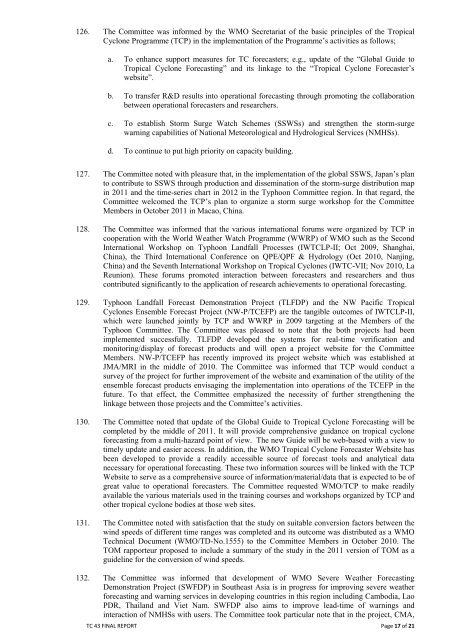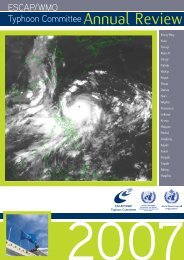1 - Typhoon Committee
1 - Typhoon Committee
1 - Typhoon Committee
Create successful ePaper yourself
Turn your PDF publications into a flip-book with our unique Google optimized e-Paper software.
126. The <strong>Committee</strong> was informed by the WMO Secretariat of the basic principles of the TropicalCyclone Programme (TCP) in the implementation of the Programme’s activities as follows;a. To enhance support measures for TC forecasters; e.g., update of the “Global Guide toTropical Cyclone Forecasting” and its linkage to the “Tropical Cyclone Forecaster’swebsite”.b. To transfer R&D results into operational forecasting through promoting the collaborationbetween operational forecasters and researchers.c. To establish Storm Surge Watch Schemes (SSWSs) and strengthen the storm-surgewarning capabilities of National Meteorological and Hydrological Services (NMHSs).d. To continue to put high priority on capacity building.127. The <strong>Committee</strong> noted with pleasure that, in the implementation of the global SSWS, Japan’s planto contribute to SSWS through production and dissemination of the storm-surge distribution mapin 2011 and the time-series chart in 2012 in the <strong>Typhoon</strong> <strong>Committee</strong> region. In that regard, the<strong>Committee</strong> welcomed the TCP’s plan to organize a storm surge workshop for the <strong>Committee</strong>Members in October 2011 in Macao, China.128. The <strong>Committee</strong> was informed that the various international forums were organized by TCP incooperation with the World Weather Watch Programme (WWRP) of WMO such as the SecondInternational Workshop on <strong>Typhoon</strong> Landfall Processes (IWTCLP-II; Oct 2009, Shanghai,China), the Third International Conference on QPE/QPF & Hydrology (Oct 2010, Nanjing,China) and the Seventh International Workshop on Tropical Cyclones (IWTC-VII; Nov 2010, LaReunion). These forums promoted interaction between forecasters and researchers and thuscontributed significantly to the application of research achievements to operational forecasting.129. <strong>Typhoon</strong> Landfall Forecast Demonstration Project (TLFDP) and the NW Pacific TropicalCyclones Ensemble Forecast Project (NW-P/TCEFP) are the tangible outcomes of IWTCLP-II,which were launched jointly by TCP and WWRP in 2009 targeting at the Members of the<strong>Typhoon</strong> <strong>Committee</strong>. The <strong>Committee</strong> was pleased to note that the both projects had beenimplemented successfully. TLFDP developed the systems for real-time verification andmonitoring/display of forecast products and will open a project website for the <strong>Committee</strong>Members. NW-P/TCEFP has recently improved its project website which was established atJMA/MRI in the middle of 2010. The <strong>Committee</strong> was informed that TCP would conduct asurvey of the project for further improvement of the website and examination of the utility of theensemble forecast products envisaging the implementation into operations of the TCEFP in thefuture. To that effect, the <strong>Committee</strong> emphasized the necessity of further strengthening thelinkage between those projects and the <strong>Committee</strong>’s activities.130. The <strong>Committee</strong> noted that update of the Global Guide to Tropical Cyclone Forecasting will becompleted by the middle of 2011. It will provide comprehensive guidance on tropical cycloneforecasting from a multi-hazard point of view. The new Guide will be web-based with a view totimely update and easier access. In addition, the WMO Tropical Cyclone Forecaster Website hasbeen developed to provide a readily accessible source of forecast tools and analytical datanecessary for operational forecasting. These two information sources will be linked with the TCPWebsite to serve as a comprehensive source of information/material/data that is expected to be ofgreat value to operational forecasters. The <strong>Committee</strong> requested WMO/TCP to make readilyavailable the various materials used in the training courses and workshops organized by TCP andother tropical cyclone bodies at those web sites.131. The <strong>Committee</strong> noted with satisfaction that the study on suitable conversion factors between thewind speeds of different time ranges was completed and its outcome was distributed as a WMOTechnical Document (WMO/TD-No.1555) to the <strong>Committee</strong> Members in October 2010. TheTOM rapporteur proposed to include a summary of the study in the 2011 version of TOM as aguideline for the conversion of wind speeds.132. The <strong>Committee</strong> was informed that development of WMO Severe Weather ForecastingDemonstration Project (SWFDP) in Southeast Asia is in progress for improving severe weatherforecasting and warning services in developing countries in this region including Cambodia, LaoPDR, Thailand and Viet Nam. SWFDP also aims to improve lead-time of warnings andinteraction of NMHSs with users. The <strong>Committee</strong> took particular note that in the project, CMA,TC 43 FINAL REPORT Page 17 of 21
















